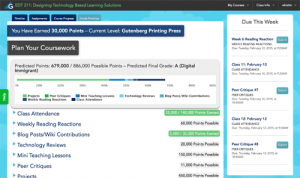

Makenzie Trowbridge left class the first day of the semester with a clear vision of what she needed to do: She’d have to earn a whopping 700,000 points to claim an A in the class.
Game on.
“I’m one of those students who’s going to try to get all the points I can,” she said. “It’s nice because usually you’re starting with an A and trying to keep it. But here, you’re starting with nothing and working your way up. In a way, you can pick your own grade.”
Trowbridge is in two education courses this semester that are part of a pilot program to test out a new learning management system (LMS). GradeCraft is a game-inspired LMS designed to facilitate autonomy while building student competence in the subject area. It not only motivates students in nontraditional ways, but also leverages learning analytics to better inform the instructor on a student's strengths, weaknesses and interests so that the instructor can best understand how to help students succeed.
“GradeCraft is about giving students control and the opportunity to customize their experience. Students feel like they’re able to make more decisions about the path they take,” said Associate Professor Stein Brunvand, who is using the system in EDT 211/511: Designing Technology Based Learning Solutions.
Students choose from a list of assignments provided at the beginning of the semester by the professor. Each assignment is an opportunity to add points, or “level up,” to unlock more assignments and get closer to the end goal.
For example, Trowbridge might decide to earn her points through a series of presentations, two quizzes and class participation. Her classmate, on the other hand, could pick one presentation, a handful of technology reviews, blog posts and a research paper.
Assistant Professor David Hill has noticed a change in mood since implementing GradeCraft in EDN 402/502 Social-Vocational Transitions. When every assignment is a chance to move closer to an A—as opposed to a chance to blow your class average on a bad day—students become more relaxed and engaged.
“I sense less stress in the class,” Hill said. “I see more focus on getting it right and learning, as opposed to the pressure of getting an A on every assignment.”
The two GradeCraft classes offered this semester are part of a pilot program run through U-M Ann Arbor. Sara Molnar, an instructional learning assistant who helped bring the program to UM-Dearborn’s College of Education, Health, and Human Services, hopes GradeCraft can inspire the next generation of educators.
“Much of the way we still teach pre-service teachers is in an antiquated, teacher-driven model that does not encourage student autonomy and creativity,” she said. “I hope all pre-service teachers can take some, if not all, aspects of this engaging pedagogy into their future classrooms to transform the way students learn.”
Molnar already may have one convert. Asked if she’d consider implementing something like GradeCraft in her future classroom, Trowbridge didn’t hesitate. “I definitely can see it in my classroom,” she said. “I think it’s a good way to get students motivated.”





